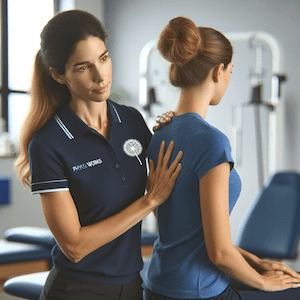Scheuermann's Disease

What is Scheuermann’s Disease?
Scheuermann’s disease affects the spine during development, resulting in abnormal growth of the thoracic (upper back) vertebrae and sometimes the lumbar vertebrae. It causes one side of the vertebral body to grow more than the other, resulting in a wedge shape and increased dorsal kyphosis or curvature of the upper back. Endplate irregularities, which refer to changes in the bone-disc interface, are another feature of Scheuermann’s disease. These changes can cause intervertebral spinal discs to protrude into the vertebra, resulting in bone depressions called Schmorl’s nodes, which usually do not cause any problems.
Calvé disease and juvenile osteochondrosis of the spine are alternative names for Scheuermann’s disease. Although it’s more common in adolescents, adults can also develop it.
What Causes Scheuermann’s Disease?
Medical attention and treatment are necessary for Scheuermann’s disease, a structural spine abnormality. Although its exact cause has yet to be fully understood, poor posture does not cause it—abnormal thoracic vertebrae growth during adolescence results in Scheuermann’s disease. Various factors influence Scheuermann’s disease, including genetic and hormonal imbalances, malabsorption, endocrine disorders, infection, and biomechanical factors such as a shortened sternum.
What are the Symptoms of Scheuermann’s Disease?
Symptoms of Scheuermann’s disease include pain and stiffness in the upper back, an increased curvature, and a limited range of motion. Physical activity may exacerbate symptoms, but some people may not experience any symptoms.
An increased curvature of the upper back, known as an increased thoracic or mid/upper back kyphosis, is one of the hallmark symptoms of Scheuermann’s disease. This curvature can visibly cause a rounding of the shoulders and a hunched posture.
How is Scheuermann’s Disease Diagnosed?
Healthcare providers diagnose Scheuermann’s disease through physical examination and imaging tests, including X-rays and MRI. Diagnosis is via X-rays. Additional tests, such as bone density or blood tests, may be ordered to rule out other conditions. It’s essential to have a qualified healthcare professional make the diagnosis, as other conditions can cause similar symptoms and imaging findings.
Scheuermann’s Disease Treatment
Scheuermann’s disease treatment typically involves several phases, each aimed at addressing different aspects of the condition and promoting healing and recovery.
PHASE I – Pain Relief and Protection:
The primary goal of the initial phase of treatment is to manage pain and inflammation. Treatment may involve ice or heat therapy, acupuncture, unloading taping, and soft tissue massage to reduce pain and inflammation. Your doctor may also recommend non-steroidal anti-inflammatory drugs (NSAIDs) or pain relievers to manage pain. During this phase, avoiding heavy loading of the thoracic spine and vigorous bending exercises is essential.
PHASE II – Restoring Normal Range of Motion and Strength:
As pain and inflammation begin to subside, the focus of treatment shifts to restoring normal range of motion and strength. Treatment may involve specific exercises to improve extension and muscle recruitment patterns and strengthen the muscles that control movement and posture in the back. Your physiotherapist will assess your needs and prescribe exercises tailored to your condition and goals.
PHASE III – Restoring Full Function:
After restoring normal motion and strength, the focus is on restoring full function and returning to activities.
PHASE IV – Preventing Future Dysfunction:
To prevent future problems, maintain excellent flexibility in the back and keep core muscles healthy to maintain good posture and reasonable control over the vertebrae. Your physiotherapist may prescribe exercises or guide you on maintaining good back health to prevent future dysfunction.
Scheuermann’s Disease Prognosis
Scheuermann’s disease has a good prognosis for most people, with the pain eventually passing and no further trouble from the thoracic vertebrae. However, some individuals may have a reduced range of motion or ongoing postural issues if there is significant kyphosis. You may use a posture brace to encourage proper spinal alignment and muscle activation. Surgery to correct the spine’s position is rare and only considered in cases where the disease process is substantial. Working with a physiotherapist is essential to monitor symptoms and progress through appropriate treatment options.
More info:
Rochedale - Call 38410277
Book Online: RochedaleSalisbury - Call 32751044
Book Online: SalisburySandgate - Call 32691122
Book Online: SandgateEffective Management of Upper Back Pain and Injury
Physiotherapy Insights
Introduction
Upper back pain and injury, predominantly affecting the thoracic spine, are prevalent issues causing significant discomfort and impacting daily activities. This article, infused with physiotherapy insights, aims to enlighten the general public about the causes, symptoms, and treatment options for upper back pain.


Managing Upper Back Pain
Upper back pain stems from various sources, including thoracic spine conditions, joint injuries, muscle strains, nerve irritations, and systemic diseases. Recognising these causes is vital for appropriate treatment.
Common Causes of Upper Back Pain
- Joint Injuries: Facet joint pain is a frequent issue.
- Muscle-Related Injuries: This includes back muscle pain, side strains, whiplash, muscle cramps, and DOMS (Delayed Onset Muscle Soreness).
- Bone-Related Injuries: Conditions like Scheuermann's Disease, Scoliosis, and others.
- Disc-Related Injuries: Including bulging, slipped, or herniated discs.
- Nerve-Related Pain: Such as thoracic outlet syndrome and pinched nerves.
- Systemic Diseases: These include Ankylosing Spondylitis, Fibromyalgia, and arthritis types.
Posture and Upper Back Pain
Poor posture is a significant contributor to upper back pain. Understanding and correcting sitting, standing, and sleeping postures can prevent and alleviate pain.
Physiotherapy Perspective
A physiotherapist's approach to treating upper back pain involves assessing the individual's condition and tailoring a treatment plan. This may include exercises, manual therapy, and advice on posture correction.
Latest Research and Techniques
Recent advancements in physiotherapy have introduced innovative methods for treating upper back pain. These include targeted exercises, advanced manual techniques, and utilisation of posture-improving products.
What to Do?
If you experience upper back pain, it's crucial to consult a physiotherapist for a professional assessment and personalised treatment plan.
Conclusion
Upper back pain, though common, can be effectively managed with the right approach. Understanding its causes and seeking professional physiotherapy advice are key steps towards recovery.
For more information, explore articles at PhysioWorks.
Related Articles
Joint Injuries
Muscle-Related Injuries
Bone-Related Injuries
Disc-Related Injuries
Nerve-Related / Referred Pain
Systemic Diseases
Posture Information
- Posture Syndromes
- Posture Improvement: A Guide to Improve Your Posture
- Improving Your Posture: A Guide for Better Health
- How to Achieve Perfect Posture




